大学毕业论文设计_发展中国家绿色贸易壁垒的特点与发展趋势及对中国的启示
最新绿色贸易壁垒的特征及负面影响1论文
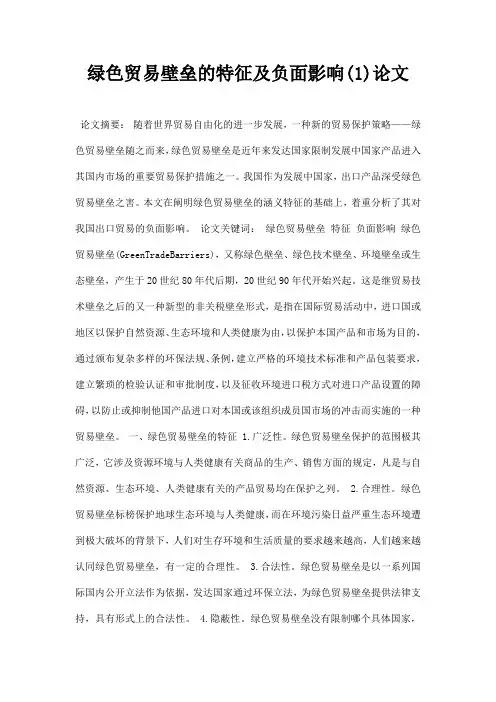
绿色贸易壁垒的特征及负面影响(1)论文论文摘要:随着世界贸易自由化的进一步发展,一种新的贸易保护策略——绿色贸易壁垒随之而来,绿色贸易壁垒是近年来发达国家限制发展中国家产品进入其国内市场的重要贸易保护措施之一。
我国作为发展中国家,出口产品深受绿色贸易壁垒之害。
本文在阐明绿色贸易壁垒的涵义特征的基础上,着重分析了其对我国出口贸易的负面影响。
论文关键词:绿色贸易壁垒特征负面影响绿色贸易壁垒(GreenTradeBarriers),又称绿色壁垒、绿色技术壁垒、环境壁垒或生态壁垒,产生于20世纪80年代后期,20世纪90年代开始兴起。
这是继贸易技术壁垒之后的又一种新型的非关税壁垒形式,是指在国际贸易活动中,进口国或地区以保护自然资源、生态环境和人类健康为由,以保护本国产品和市场为目的,通过颁布复杂多样的环保法规、条例,建立严格的环境技术标准和产品包装要求,建立繁琐的检验认证和审批制度,以及征收环境进口税方式对进口产品设置的障碍,以防止或抑制他国产品进口对本国或该组织成员国市场的冲击而实施的一种贸易壁垒。
一、绿色贸易壁垒的特征 1.广泛性。
绿色贸易壁垒保护的范围极其广泛,它涉及资源环境与人类健康有关商品的生产、销售方面的规定,凡是与自然资源、生态环境、人类健康有关的产品贸易均在保护之列。
2.合理性。
绿色贸易壁垒标榜保护地球生态环境与人类健康,而在环境污染日益严重生态环境遭到极大破坏的背景下,人们对生存环境和生活质量的要求越来越高,人们越来越认同绿色贸易壁垒,有一定的合理性。
3.合法性。
绿色贸易壁垒是以一系列国际国内公开立法作为依据,发达国家通过环保立法,为绿色贸易壁垒提供法律支持,具有形式上的合法性。
4.隐蔽性。
绿色贸易壁垒没有限制哪个具体国家,表面上是一视同仁。
但是绿色贸易壁垒隐蔽于具体的贸易法规和国际公约的执行过程中,各种检验标准极为复杂,往往使出口国难以应付和适应。
二、绿色贸易壁垒对我国出口贸易的负面影响 1.出口产品的数额减少。
浅谈绿色贸易壁垒的特征及对我国贸易的影响
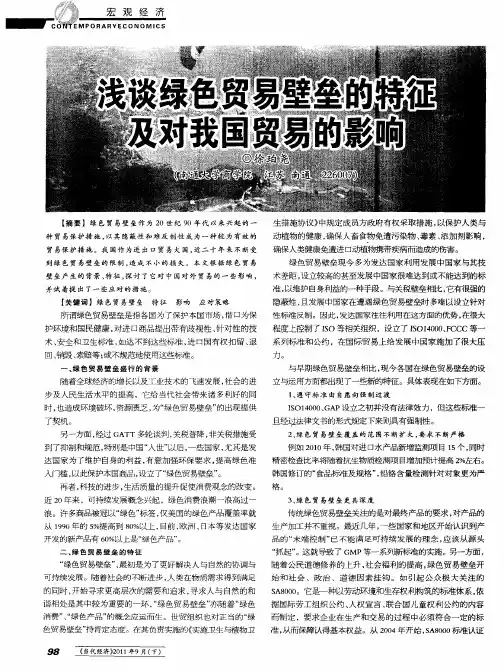
随着全球经济的增长以及工业技术的飞速发展 , 社会的进 步及 人民生活水平 的提 高 ,它给 当代 社会带来 诸 多利好 的同 时, 也造成环境破坏 , 资源匮乏 , 绿色贸易壁垒 ” 为“ 的出现提供
了契机 。 另一方面 , 经过 G T A T多轮谈判 , 关税普降 , 非关税措施 受
入门槛 , 以此保护本 国商品 , 设立了“ 绿色贸易壁垒 ” 。 再者, 科技的进步 , 生活质量的提升促使 消费观 念的改 变。 近 2 年来 ,可持续发展概念兴起 ,绿色消费浪潮一浪高过 一 o
浪。许多商品被冠 以“ 绿色” 标签 , 仅美国的绿色产品覆盖率就
从 19 的 5 高 到 8%以 上 , 9 0年 %提 0 目前 , 洲 、 欧 日本 等 发 达 国 家 开 发 的 新 产 品有 6%以 上是 “ 色 产品 ” 0 绿 。
“ 绿色贸易壁垒 ”最初是 为了更好 解决人与 自然的协调与 ,
可 持 续 发 展 。随 着 社 会 的 不断 进 步 , 类 在 物质 需 求 得 到 满 足 人
随 着公民道德修 养的上升 , 社会福 利的提 高 , 绿色贸
始 和 社会 、政 治 、道德 因 素挂 钩 。如 引起 公众 极
立与运用方面都出现了一些新的特征 。具体表现在如‘
1 遵 守 标 准 由 自愿 向 强 制 过 渡 、
IO10 0 G P设 立之初并没有法律效力 ,但这 S 40、 A
旦经过法律文书的形式规定下来则具 有强制性 。
2 绿 色 贸 易壁 垒覆 盖 的 范 围不 断 扩 大 , 求 不 断严 、 要
的同时 , 开始寻求 更高层次 的需 要和追求 , 寻求 人与 自然 的和
谐相处是其 中较 为重要的 一环 ,绿色 贸易壁垒 ” 随着 “ 色 “ 亦 绿
毕业论文范例-绿色贸易壁垒对我国外贸的影响及对策分析

绿色贸易壁垒对我国外贸的影响及对策分析摘要随着世界各国经济的发展,国际贸易规模不断扩大,环境问题日益突出。
各国为了保护环境而采取的一些措施直接或间接地限制甚至禁止了某些产品的贸易,成为绿色贸易壁垒。
另一方面,在经济全球化和贸易自由化的浪潮中,关税和传统非关税壁垒的使用受到了越来越多的限制,贸易保护者转而寻求新的贸易保护工具。
在贸易与环境的矛盾下,绿色贸易壁垒便成为他们实施贸易保护的有力武器。
作为一个贸易大国,绿色贸易壁垒已经影响到中国对外贸易的发展,几乎波及到我国外贸出口的所有领域。
因此,系统地研究绿色贸易壁垒,分析绿色贸易壁垒对中国对外贸易的影响及如何合理构筑我国的绿色贸易壁垒就具有重要的理论和现实意义。
论文共分为六个部分:第一部分介绍了论题的研究目的与意义,国内为对绿色贸易壁垒的研究概况以及本文的研究内容与方法。
第二部分从绿色贸易壁垒产生的背景与原因出发,在对绿色贸易壁垒的概念进行界定的基础下,分析其产生的原因,介绍了绿色贸易壁垒的内容,总结了它的特征。
第三部分选择绿色关税与绿色补贴、环境标准等措施,运用局部均衡和福利经济学的方法来对绿色贸易壁垒的经济效应进行分析。
第四部分分析绿色贸易壁垒对国际贸易的影响。
第五部分介绍了我国应对绿色贸易壁垒的对策。
第六部分为结语,对全文进行概括性的总结。
【关键词】绿色贸易壁垒对外贸易影响对策ABSTRACTWith the development of the world economy and the expansion of international business activities, environment problems have become more and more serious. For protecting its own environment, each country adopts some certain measures that restrict or even prohibit trade activities of some products in a direct or indirect way, which becomes the Green Barriers in the international business and trade. On the other hand, in the tides of economic globalization and trade freedom, the application of tariffs and other non-tariff barriers is confronting more and more restrictions. Thus those protectionists turn to search for new protection tools for the trade. Under the confliction of the between the trade and environment expansion, the Green Barriers naturally become the most powerful tools to implement their trade their protection. As a very important country in the international, the Green Barriers have greatly influenced China’s foreign trade and almost affected all the fields in our exportation. Therefore, to make a systematical research and analysis on the Green Barriers, their influence to China’s international trade and how to properly construct our own Green Barriers is very essential both theoretically and realistically.The article is divided into six parishes. In the first part, Preface which expatiates systematically on the aim and meaning of research, research actuality in domestic and abroad, the innovation, research logic and approach. In the second part theoretically analyses the causation, contents and features of its origin. In the third part it compares the different economic effects of Green Tariff, Green Payment and some other environmental standards, through the analysis methods of partial equilibrium and the welfare economics. The fourth part analyses the influence and impact of the Green Barriers to the international trade. The fifth part is makes a prediction on the development tendency of the Green Barriers and gives out several corresponding countermeasures and suggestions feasible for China. The last part is the epilogue, which summarizes the paper recapitulative.【Key Words】green trade barrier foreign trade influence strategy目录1 绪论 (2)1.1 研究的背景和意义 (2)1.2 国内外研究现状 (2)1.3研究方法 (4)2 绿色贸易壁垒的相关理论 (4)2.1 绿色贸易壁垒的产生和发展 (4)2.2 绿色贸易壁垒的定义和特征 (5)2.3 绿色贸易壁垒的表现形式 (6)3 绿色贸易壁垒对我国对外贸易的影响 (7)3.1 我国对外贸易所面临的挑战 (7)3.2 绿色贸易壁垒给我国对外贸易带来的机遇 (10)4 我国应对绿色贸易壁垒影响的对策 (11)4.1 建立绿色贸易壁垒的预警机制 (11)4.2 建立完善的环境标志制度 (11)4.3 进行绿色认证 (12)4.4 加强认证机构建设,提高认证工作的权威性 (12)4.5 搜集国际市场“绿色信息” (12)4.6 开发绿色产品 (12)4.7 加强国际合作,抵制绿色保护主义 (13)4.8 鼓励技术创新,扶持绿色产业 (13)4.9 研究发达国家的贸易制度和运作方式以及在绿色贸易壁垒方面采取的战略措施 (13)5 结论 (14)参考文献 (15)致谢............................... 错误!未定义书签。
国际商务-毕业论文绿色贸易壁垒对我国外贸的影响
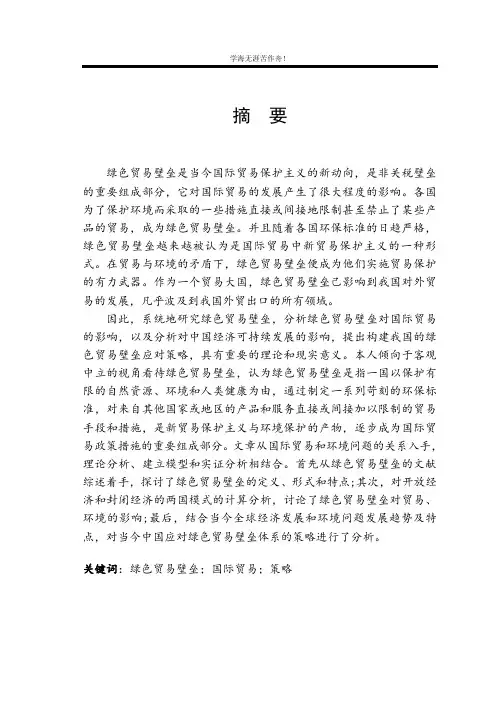
摘要绿色贸易壁垒是当今国际贸易保护主义的新动向,是非关税壁垒的重要组成部分,它对国际贸易的发展产生了很大程度的影响。
各国为了保护环境而采取的一些措施直接或间接地限制甚至禁止了某些产品的贸易,成为绿色贸易壁垒。
并且随着各国环保标准的日趋严格,绿色贸易壁垒越来越被认为是国际贸易中新贸易保护主义的一种形式。
在贸易与环境的矛盾下,绿色贸易壁垒便成为他们实施贸易保护的有力武器。
作为一个贸易大国,绿色贸易壁垒己影响到我国对外贸易的发展,凡乎波及到我国外贸出口的所有领域。
因此,系统地研究绿色贸易壁垒,分析绿色贸易壁垒对国际贸易的影响,以及分析对中国经济可持续发展的影响,提出构建我国的绿色贸易壁垒应对策略,具有重要的理论和现实意义。
本人倾向于客观中立的视角看待绿色贸易壁垒,认为绿色贸易壁垒是指一国以保护有限的自然资源、环境和人类健康为由,通过制定一系列苛刻的环保标准,对来自其他国家或地区的产品和服务直接或间接加以限制的贸易手段和措施,是新贸易保护主义与环境保护的产物,逐步成为国际贸易政策措施的重要组成部分。
文章从国际贸易和环境问题的关系入手,理论分析、建立模型和实证分析相结合。
首先从绿色贸易壁垒的文献综述着手,探讨了绿色贸易壁垒的定义、形式和特点;其次,对开放经济和封闭经济的两国模式的计算分析,讨论了绿色贸易壁垒对贸易、环境的影响;最后,结合当今全球经济发展和环境问题发展趋势及特点,对当今中国应对绿色贸易壁垒体系的策略进行了分析。
关键词:绿色贸易壁垒;国际贸易;策略AbstractGreen trade barriers,the new trend of international trade protectionism,are an important part of non-tariff barriers,which have significant influence on the development of international trade. In order to protect their own environment,the world nations adopt some measures,directly or indirectly,to restrict or even prohibit trade activities of some products,which serves as the Green Barriers in the international business and trade. With the increasing critical environmental standards,the Green Barrier has been becoming a new form of trade protectionism in the world trade. When in face of the conflict between trade and environment,the Green Barriers can be a powerful weapon of trade protectionism. As China has become a trading power, the Green Barriers has influenced the development of China’s foreign trade,nearly including all its fields. Therefore,it is of theoretical and realistic significance to study the Green Barriers and its influence on international trade and the sustainable development of China’s economy systematically and finally put forward the strategies to cope with the Green Barriers and properly construct our own Green Barriers. The author tends to view the Green Barriers in a neutral and objective perspective. The thesis holds the opinion that the Green Barriers are the trade instruments and measures taken by a nation to protect the limited resources,environment and human health,which restrict the products and services from other countries and regions through formulating a series of environmental standards. Besides,it is the product of new trade protectionism and environmental protection,which gradually becomes an important part of international trade policies and measures. The thesis makes an analysis of the international trade and environmental protection,through theoretical analysis,modeling and empirical analysis. It begins with the literature review of the Green Barriers,which includes its definition,forms and characteristics; then, it makes a calculation analysis mainly by using the inclose and exoteric conditions,and discuss the two countries’mode influence of Green Barriers on trade and environment: lastly,through combining the present global economical growth and environmental development trend,it analyzes China’s current strategies for the Green Barriers.Key words:Green Trade Barriers;International Trade;Strategy目录1 绿色贸易壁垒的相关理论 (1)1.1研究背景 (1)1.2研究内容与研究方法 (1)1.3绿色贸易壁垒的含义 (2)1.4绿色贸易壁垒产生的原因 (2)1.5 绿色贸易壁垒的特点 (4)1.6绿色贸易壁垒的表现形式 (6)2 绿色贸易壁垒对我国外贸的影响 (7)2.1绿色贸易壁垒对我国出口的影响 (7)2.2绿色贸易壁垒对我国进口的影响 (8)3 我国应对绿色贸易壁垒的对策 (9)3.1政府的对策 (9)3.2行业协会的对策 (10)3.3企业的对策 (11)结束语 (12)参考文献 (13)1 绿色贸易壁垒的相关理论1.1 研究背景绿色贸易壁垒的含义是指环境(非关税)壁垒,是国际社会为保护人类,动植物及生态环境的健康和安全而采取的直接或间接限制甚至禁止某些商品进出口的法律、法规和政策措施。
浅谈绿色壁垒及中国的对策(一)
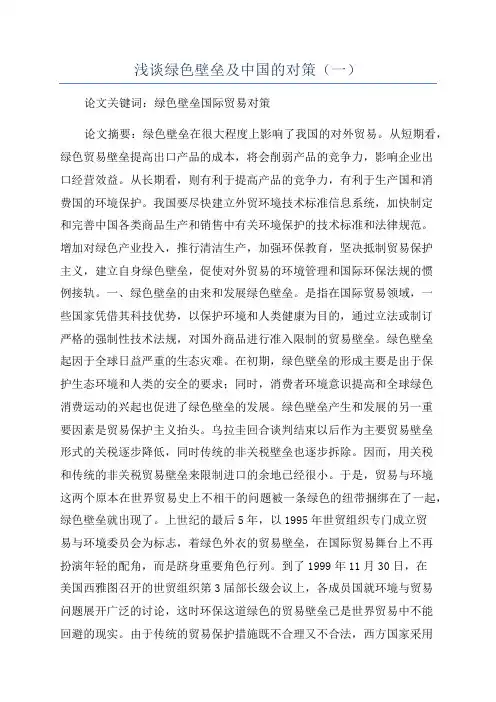
浅谈绿色壁垒及中国的对策(一)论文关键词:绿色壁垒国际贸易对策论文摘要:绿色壁垒在很大程度上影响了我国的对外贸易。
从短期看,绿色贸易壁垒提高出口产品的成本,将会削弱产品的竞争力,影响企业出口经营效益。
从长期看,则有利于提高产品的竞争力,有利于生产国和消费国的环境保护。
我国要尽快建立外贸环境技术标准信息系统,加快制定和完善中国各类商品生产和销售中有关环境保护的技术标准和法律规范。
增加对绿色产业投入,推行清洁生产,加强环保教育,坚决抵制贸易保护主义,建立自身绿色壁垒,促使对外贸易的环境管理和国际环保法规的惯例接轨。
一、绿色壁垒的由来和发展绿色壁垒。
是指在国际贸易领域,一些国家凭借其科技优势,以保护环境和人类健康为目的,通过立法或制订严格的强制性技术法规,对国外商品进行准入限制的贸易壁垒。
绿色壁垒起因于全球日益严重的生态灾难。
在初期,绿色壁垒的形成主要是出于保护生态环境和人类的安全的要求;同时,消费者环境意识提高和全球绿色消费运动的兴起也促进了绿色壁垒的发展。
绿色壁垒产生和发展的另一重要因素是贸易保护主义抬头。
乌拉圭回合谈判结束以后作为主要贸易壁垒形式的关税逐步降低,同时传统的非关税壁垒也逐步拆除。
因而,用关税和传统的非关税贸易壁垒来限制进口的余地已经很小。
于是,贸易与环境这两个原本在世界贸易史上不相干的问题被一条绿色的纽带捆绑在了一起,绿色壁垒就出现了。
上世纪的最后5年,以1995年世贸组织专门成立贸易与环境委员会为标志,着绿色外衣的贸易壁垒,在国际贸易舞台上不再扮演年轻的配角,而是跻身重要角色行列。
到了1999年11月30日,在美国西雅图召开的世贸组织第3届部长级会议上,各成员国就环境与贸易问题展开广泛的讨论,这时环保这道绿色的贸易壁垒已是世界贸易中不能回避的现实。
由于传统的贸易保护措施既不合理又不合法,西方国家采用一些新的合理合法的贸易保护措施来保护本国利益。
其中环保措施具有更大的隐蔽性和灵活性,容易受到公众和世界各国的认同,成为贸易保护最有影响力的措施。
毕业论文---绿色贸易壁垒对中国农产品出口的影响及对策
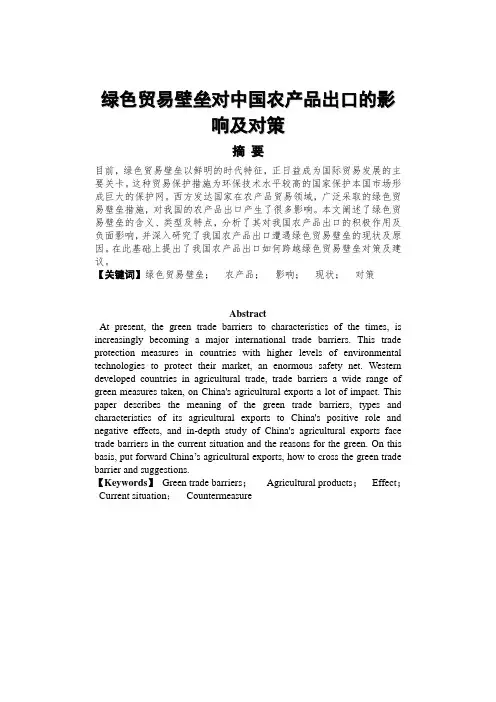
绿色贸易壁垒对中国农产品出口的影响及对策摘要目前,绿色贸易壁垒以鲜明的时代特征,正日益成为国际贸易发展的主要关卡。
这种贸易保护措施为环保技术水平较高的国家保护本国市场形成巨大的保护网。
西方发达国家在农产品贸易领域,广泛采取的绿色贸易壁垒措施,对我国的农产品出口产生了很多影响。
本文阐述了绿色贸易壁垒的含义、类型及特点,分析了其对我国农产品出口的积极作用及负面影响,并深入研究了我国农产品出口遭遇绿色贸易壁垒的现状及原因。
在此基础上提出了我国农产品出口如何跨越绿色贸易壁垒对策及建议。
【关键词】绿色贸易壁垒;农产品;影响;现状;对策AbstractAt present, the green trade barriers to characteristics of the times, is increasingly becoming a major international trade barriers. This trade protection measures in countries with higher levels of environmental technologies to protect their market, an enormous safety net. Western developed countries in agricultural trade, trade barriers a wide range of green measures taken, on China's agricultural exports a lot of impact. This paper describes the meaning of the green trade barriers, types and characteristics of its agricultural exports to China's positive role and negative effects, and in-depth study of China's agricultural exports face trade barriers in the current situation and the reasons for the green. On this basis, put forward China’s agricultural exports, how to cross the green trade barrier and suggestions.【Keywords】Green trade barriers;Agricultural products;Effect;Current situation;Countermeasure1 引言众所周知,中国是农产品的生产大国和出口大国。
绿色贸易壁垒对我国的影响及其应对措施
绿色贸易壁垒对我国的影响及其应对措施第一篇:绿色贸易壁垒对我国的影响及其应对措施摘要] 绿色贸易壁垒又称环境壁垒,是指进口国政府以保护生态环境、自然资源和人类健康为由,以限制进口保护贸易为目的,通过颁布复杂多样的环保法规、条例,建立严格的环境技术标准和产品包装要求,建立繁琐的检验认证和审批制度,以及征收环境进口税方式对进口产品设置的贸易障碍。
与传统的非关税壁垒相比,绿色贸易壁垒具有名义上的合理性、形式上的合法性、保护内容的广泛性、保护方式的隐蔽性和实施效果的歧视性等特征。
本文分析了绿色贸易壁垒对我国的影响,作者还提出了应对绿色贸易壁垒的措施建议。
(正文)绿色贸易壁垒又称环境壁垒,是指进口国政府以保护生态环境、自然资源和人类健康为由,以限制进口保护贸易为目的,通过颁布复杂多样的环保法规、条例,建立严格的环境技术标准和产品包装要求,建立繁琐的检验认证和审批制度,以及征收环境进口税方式对进口产品设置的贸易障碍。
与传统的非关税壁垒相比,绿色贸易壁垒具有名义上的合理性、形式上的合法性、保护内容的广泛性、保护方式的隐蔽性和实施效果的歧视性等特征。
绿色贸易壁垒作为一种非关税壁垒产生于20世纪80年代后期,90年代开始兴起,最典型的是1991年美国禁止进口墨西哥的金枪鱼及其制品,其理由是为了保护海豚的生存。
日本、欧洲等发达国家也纷纷效仿,绿色贸易壁垒开始流行。
绿色贸易壁垒的兴起有其深刻的背景,其实质上是发达国家借环境保护之名,依赖其技术和环保水平,通过立法手段,制定严格的强制性的技术、环境标准,以行其贸易保护之实,将发展中国家的一些商品拒之门外。
一、绿色贸易壁垒的主要制度安排在新的一轮贸易保护主义运动中,发达国家利用自身的技术优势,先后出台了各种环保法规、标准、绿色标志等创新的制度安排,以期达到抑制负外部性的输入和保护国内经济的目的。
1.环境附加税和市场准入制度。
发达国家保护环境、限制进口最早的手段是采用环境附加税,即对一些污染环境、影响生态的进口产品征收进口附加税,或者限制、禁止进口,甚至实行贸易制裁。
谈绿色贸易壁垒的新特征及对我国出口贸易的影响
谈绿色贸易壁垒的新特征及对我国出口贸易的影响内容摘要:随着世界经济一体化的发展,绿色贸易壁垒正迅速发展起来。
这种贸易壁垒具有隐蔽性及表面上的合理性等特征,已经成为国际贸易中实行贸易保护的有效手段。
本文围绕“绿色贸易壁垒”这一中心问题,结合相关领域的最新动态,主要分析了绿色贸易壁垒近年来呈现出的新特点及对我国外贸出口企业带来的影响,探讨了我国应对绿色贸易壁垒时的措施。
关键词:绿色贸易壁垒新特征影响绿色贸易壁垒指一国或地区为了保障人类生命健康、保护动植物安全或维护生态和环境,凭借自身的经济和科技优势,利用本国制定的法律法规或协定的环境保护条款,对进口的产品设置严格的环境技术标准以限制或禁止进口的一种手段。
主要表现为绿色环境标志、绿色包装制度、绿色技术标准和绿色卫生检验检疫制度等。
尽管绿色贸易壁垒引起了广泛的争议,它还是越来越频繁地出现在国际贸易领域。
近年来,它被使用的频率越来越高,并且呈现出了一系列新特征。
绿色贸易壁垒的新特征(一)自愿性措施向强制性转变目前,国际上很多的认证体系、绿色标志等都是以生产者自愿为基础决定是否认证,并没有强制的法律效力,如ISO14000、GAP等。
但是近年来,这种自愿性的措施呈现向强制性转化的趋势,一旦这些标准以法律的形式确定下来,就具有了强制的法律效力,对进口商品的要求将更加严格。
另外,一些国家国内的技术标准也开始向强制性转化。
如2010年2月24日,泰国发布了含石棉产品强制性标签通报,规定了含石棉产品应具有强制性规定的重要信息的标签,即指示、警告及其他信息,例如,名称、商标名称、照片、设备及其他资料。
(二)范围不断扩大且标准日趋严格随着人们对环保问题的日益关注,各国和地区根据技术水平不断修订技术标准,变动频率越来越高,导致产品质量检查不断升级,安全卫生控制指标日趋严格。
例如2010年,韩国对进口水产品新增检测项目15个,包括庆大霉素、泰妙菌素、一氧化碳等,覆盖了鱼、甲壳类及头足类等主要品种,同时精密检查比率将随着抗生物质检测项目增加预计提高2%左右。
绿色贸易壁垒论文(5篇)
绿色贸易壁垒论文(5篇)绿色贸易壁垒论文(5篇)绿色贸易壁垒论文范文第1篇绿色贸易壁垒也称环境贸易壁垒,是指那些以维护人类健康和环境平安为目的而实行的限制甚至禁止有关国际贸易活动的法律、法规、标准、政策及其相应的行政措施,以避开这些贸易活动可能导致的环境污染与生态破坏,实现经济与社会的可持续进展。
从另一个角度讲,所谓绿色贸易壁垒,是以爱护自然资源、生态环境和人类健康为名,通过制定一系列简单苛刻的环保标准,对来自其他国家的产品及服务设置障碍,以爱护本国产业的一种新型的非关税壁垒。
绿色贸易壁垒形式多样,包括绿色关税、环境配额、环境许可证、绿色补贴、绿色标签、绿色包装等,具有虚假性、广泛性、隐藏性等特点。
二、WTO规章中的绿色贸易壁垒WTO法律框架之下,有关绿色贸易的条款主要见于《关税与贸易总协定》、《服务贸易总协定》、《技术性贸易壁垒协议》、《补贴与反补贴协议》、《卫生与动植物检疫措施协议》以及《建立世界贸易组织协议》、《农产品贸易协定》、《与贸易有关的学问产权协定》等规章中。
由此可见,环保浪潮对乌拉圭回合的谈判产生了肯定影响,在WTO的有关文件中均涉及环境问题。
但是,WTO在此问题上的态度不明朗,条文不详细。
一方面,WTO原则上承认各个成员为了爱护各自的公共秩序和防止环境污染,有权制定本国的环保政策并组织实施;另一方面,则要求这些政策和措施不能阻碍世界自由贸易体制的正常运行,使环保措施成为变相的贸易爱护手段。
就上述规章本身而言,绿色壁垒也对WTO的基本原则造成了冲击,主要体现为:首先,它背离了自由贸易原则。
自由贸易是WTO要追求的目标,须建立在公平的基础上。
发达国家制定高标准的环境标准,使进展中国家丢失比较优势,从而使WTO的自由贸易的目标也就失去了根基。
其次,违反了普遍取消数量限制的规定,这是实现贸易自由的重要保证。
虽然不像配额许可证那样明显,但绿色壁垒所起的作用无疑是相同的。
再次,它违反了非卑视原则。
国际贸易中的绿色贸易壁垒问题的研究
国际贸易中的绿色贸易壁垒问题的研究一、绿色贸易壁垒的概念及产生原因二、绿色贸易壁垒与环保标准之间的联系三、绿色贸易壁垒对经济发展的影响及其可能的解决方案四、国际绿色贸易壁垒现状及未来趋势展望五、中外国际绿色贸易壁垒比较分析随着全球环境污染日益加剧,环境保护已成为全球重要的关注焦点。
为了保护环境和降低污染,各国开始对进口产品实施绿色贸易壁垒,这对贸易国家来说是一个严重的挑战。
本论文旨在探讨国际贸易中的绿色贸易壁垒问题,并提出相应的解决方案。
一、绿色贸易壁垒的概念及产生原因绿色贸易壁垒是指对进口商品所施加的一种限制措施,这种措施是围绕着环境、健康和安全标准而设立的。
这种限制措施可能包括环保、健康标准、认证等方面的要求。
绿色贸易壁垒的产生原因可以分为国内和国际两个层面。
国内因素包括政治因素、国内市场需求、产业政策、监管变化等方面;国际因素则包括对发展中国家的议题、国际环境条约的签署、消费者需求、竞争压力等。
二、绿色贸易壁垒与环保标准之间的联系绿色贸易壁垒与环保标准之间存在着密切联系。
环保标准作为绿色贸易的核心,可以帮助消费者根据环保标准来选择更具有环保优势和竞争力的产品。
同时,环保标准对于贸易生产者和出口国家也是极为重要的,可以帮助他们优化生产和制造过程,以应对国际市场上不断变化的需求。
三、绿色贸易壁垒对经济发展的影响及其可能的解决方案绿色贸易壁垒对经济发展产生了一定的影响。
一方面,绿色贸易壁垒可以导致一些生产成本的增加,从而使下游消费者和中游生产商面临着更高的产品价格;另一方面,绿色贸易壁垒还会导致企业面临更高的技术升级和改变产品制造方法的成本。
为了解决绿色贸易壁垒可能带来的不良影响,多数国家都在积极寻求解决方案。
一方面,企业可以通过技术改进和创新,寻求低成本、高效率生产的途径。
另一方面,政府可以加强环保标准的制定,支持企业创新和技术进步,并提供适当的政策和税收优惠。
四、国际绿色贸易壁垒现状及未来趋势展望国际绿色贸易壁垒的现状取决于各国对于环保、健康和安全等方面的标准和要求。
- 1、下载文档前请自行甄别文档内容的完整性,平台不提供额外的编辑、内容补充、找答案等附加服务。
- 2、"仅部分预览"的文档,不可在线预览部分如存在完整性等问题,可反馈申请退款(可完整预览的文档不适用该条件!)。
- 3、如文档侵犯您的权益,请联系客服反馈,我们会尽快为您处理(人工客服工作时间:9:00-18:30)。
发展中国家绿色贸易壁垒的特点与发展趋势及对中国的启示摘要随着国际贸易的发展,绿色贸易壁垒越来越成为国际贸易中的重大障碍。
发展中国家的绿色贸易壁垒在产生中存在很强的被动性,绿色贸易壁垒的法律体系和程序不健全且缺乏必要的透明度,在实施绿色贸易壁垒的过程中协调性也差。
应当促使发展中国家广泛参与国际合作,完善自己的绿色贸易壁垒,缩小与发达国家差距的趋势。
同时借鉴它们的经验,完善我国的绿色贸易壁垒体系。
积极应对国外的绿色贸易壁垒挑战。
面对绿色贸易壁垒带来的机遇和挑战,我们必须正视绿色贸易壁垒的存在,正视环境措施对国际贸易的影响,充分认识到我国在环保与贸易之间法律协调的欠缺,趋利避害,将环境措施的贸易影响纳入环境立法中,采取积极的应对措施,并合理利用绿色贸易壁垒维护我国的合法权益。
关键词发展中国家;绿色贸易壁垒;TBT;SPSAbstractWith the development of international trade,Green Barrier is increasingly becoming a major obstacle to international trade. Green Barrier in developing countries is passive in the process of its creation. Its legal system and procedures are not perfect and lack of the necessary transparency. Coordination among the developing countries is alse poor. We should pay attention to the trend that developing countries participate in international cooperation widely, improve their Green Barrier and narrow the gap with developed countries. We should learn from their experience, improve our system of Green Barrier and actively deal with foreign Green Barrier. Faced with the opportunities and challenges the green trade barriers brought about, we should envisage the existence of green trade barriers,envisage the influence of environmental measures to international trade, and realize the lack of coordination of law between environmental protection and trade. In the meantime, we should put the trade influence of environmental measures into the environmental legislation, take the active countermeasures, and use the green trade barriers to preserve our legitimate rights and interests.Key words Developing Countries; Green Barrier; TBT;SPS目录摘要 (I)Abstract (II)第1章绪论 (1)1.1 课题背景 (1)1.2 国内外研究现状 (1)1.3 研究内容 (2)第2章绿色贸易壁垒 (4)2.1 绿色贸易壁垒概述 (4)2.1.1 绿色贸易壁垒的含义 (4)2.1.2 绿色贸易壁垒的特征 (4)2.1.3 绿色贸易壁垒的表现形式 (5)2.1.4 绿色贸易壁垒的成因分析 (5)2.2 绿色壁垒带来的影响 (6)2.2.1 发展中国家成为发达国家“绿色壁垒”的受害者 (6)2.2.2 绿色贸易壁垒对我国的影响 (6)第3章发展中国家绿色贸易壁垒的特点 (8)3.1 绿色贸易壁垒被动性较强 (8)3.2 绿色贸易壁垒体制不健全 (8)3.2.1 法律体制不健全 (8)3.2.2 设立和实施程序体制不健全 (9)3.2.3 管理体制不健全 (9)3.3 普遍缺乏透明性 (10)3.3.1 绿色贸易壁垒的设立缺乏透明性 (10)3.3.2 绿色贸易壁垒的实施缺乏透明性 (10)3.4 协调性差 (10)3.4.1 双边和多边合作很少 (10)3.4.2 参与国际合作者寡 (10)第4章发展中国家绿色贸易壁垒的发展趋势 (12)4.1 发展速度会加快 (12)4.1.1 经济的发展加速了发展中国家绿色贸易壁垒的发展 (12)4.1.2 技术的进步加速了绿色贸易壁垒的发展 (12)4.1.3 社会的进步和观念的更新加速了发展中国家绿色贸易壁垒的发展 (12)4.2 发展中国家与发达国家的差距会逐渐缩小 (13)4.3 绿色贸易壁垒会越来越完善 (13)4.4 国家间的合作会不断加强 (13)4.4.1发展中国家间的内部合作会加强 (13)4.4.2发展中国家与发达国家间的外部合作会加强 (14)4.5 更多地利用WTO机制解决争端并争取国际组织的援助 (14)第5章发展中国家绿色贸易壁垒对中国的启示 (15)5.1 完善我国绿色贸易壁垒的各项具体制度 (15)5.1.1加强和健全绿色技术标准达成与国际标准接轨 (15)5.1.2完善绿色认证制度 (15)5.1.3建立禁止污染转移制度 (16)5.1.4完善绿色包装制度 (16)5.2 以法律形式硬化我国绿色贸易壁垒制度 (16)5.3加强区域合作和国际合作 (16)5.3.1加强区域合作 (16)5.3.2加强国际合作 (17)5.4建立绿色贸易壁垒预警机制 (17)5.5企业积极应对绿色贸易壁垒 (17)5.5.1企业需具国际化眼光 (17)5.5.2同类企业间加强合作 (17)5.5.3企业要增强自我保护意识,用WTO规则维护自己的权益 (18)结论 (19)参考文献 (20)致谢 (21)附录A (22)附录B (25)第1章绪论1.1 课题背景随着世界经济的迅猛发展,带来了诸如资源短缺,环境污染,臭氧层被破坏,全球气候变暖,生态平衡等一系列世界性环境恶化问题,特别是涉及全球环境的臭氧层耗竭与生物多样性缺失,以及环境污染对食物链的危害等,使人类认识到环境污染,自然生态系统失衡,最终将危机人类自身的生存和发展。
同时,由于环境所具有的外部性特点,使得某一地区的环境破坏产生的污染,可通过空气,河流,贸易以及人员的流动而造成地区性和全球性环境外部性问题。
因此,全球聚焦环境生态保护,并演化为当代全球绿色浪潮。
绿色贸易壁垒本来是协调环境与贸易关系的共生物,它产生的目的是为了限制破坏生态环境以及威胁人类与动植物健康的贸易活动,其初衷在于通过控制乃至禁止对环境有害的产品以及产品生产设备和工艺来减轻其对进口国的环境压力,本质上讲它并不具有贸易壁垒的特征,但随着国际贸易的迅速扩大,政府对贸易的干预不断加深,当某些国家为了保护国内企业,以环境保护为名,在贸易规范中设置种种苛刻要求,以阻止外国产品进入本国市场时,就形成了绿色贸易壁垒,其实质是一种变相的贸易保护主义,直接导致社会经济基础薄弱,环保技术水平较低的发展中国家产品出口遭遇重重困难。
实施以来,引发的贸易摩擦,贸易冲突日益增加,破坏了双边和多边贸易关系的顺利发展。
1.2 国内外研究现状对于绿色贸易壁垒概念的界定,学界目前尚无共识。
有人认为“所谓绿色贸易壁垒,是指一种以保护有限资源、环境和人民健康为名,通过蓄意制定一系列苛求的环保标准,对来自国外的产品或服务加以限制”,“在世界贸易自由化的发展进程中,随着传统贸易壁垒的逐步弱化,绿色贸易壁垒正在迅速成为一种新的非关税贸易壁垒,已经越来越成为有些国家国际贸易政策措施的一部分。
”有人认为“绿色壁垒是指进口国为保护生态环境、人类及动植物健康,通过制定一系列技术性标准和法规,对来自国外的产品或服务加以限制或禁止的贸易保护措施。
”有人认为所谓绿色壁垒“是指在国际贸易中,某些国家借环境保护之名,行贸易保护之实,对外国商品制定过分高于国际公认或绝大多数国家所能接受的环保标准,或比本国商品的环保标准要高的双重标准,从而限制或禁止外国商品进口的贸易障碍。
”亦有学者指出“所谓绿色壁垒,又被称为环境壁垒、绿色保护主义。
目前国内学者形成了两种观点,其一认为绿色壁垒是指进口国政府以保护生态环境为由,以限制进口保护贸易为目的,通过颁布复杂多样的环境法规、条例,建立严格的环保技术标准和产品包装要求和烦琐的检验、认证和审批程序,实施环境标志制度以及课征环境进口税等方式对进口产品设置的贸易障碍。
另一种观点则认为绿色壁垒是发达国家通过制定高于发展中国家的环境质量标准准入条件作为限制进口的手段,从而使传统的贸易壁垒逐步演变为环境壁垒,或称绿色壁垒。
”虽然以上对绿色贸易壁垒的认识尚无统一说法,但在本质上却并无区别:绿色壁垒是一个具有负面意义的概念,其实质是推进贸易保护和限制进口。
绿色壁垒确实具有贸易保护主义倾向,也对我国贸易产生了重要影响,但这不能成为过分夸大绿色壁垒的负面影响而忽视其正面效应的理由。
从绿色贸易壁垒的产生机理来看,贸易保护虽然是促使绿色壁垒产生的因素之一,但决不是其产生的根本原因。
绿色贸易壁垒的产生与环境问题的全球化密不可分,其根本在于满足环境保护的需要,因此不能忽视或轻视绿色贸易壁垒存在的合理性及其正面功效。
虽然“壁垒”一词在WTO语境下具有谴责的意味,但仍应将绿色贸易壁垒理解成一个中性概念,应该从两方面辩证地来看待它。
一方面,不能否认绿色贸易壁垒在贸易自由化方面的阻碍作用,其已经成为贸易保护的一种新手段;另一方面,更应重视其在环境保护方面的促进作用。
因为从本来意义上说,“它是指那些以维护人类健康和环境安全为目的而采取的限制甚至禁止有关国际贸易活动的法律、法规、标准、政策及其相应的行政措施,以避免这些贸易活动可能导致的环境污染与生态破坏,实现经济与社会的可持续发展。
”绿色贸易壁垒是一柄“双刃剑”,但我国学者大多在负面意义上使用这一概念,忽视或轻视了其正面效应。
